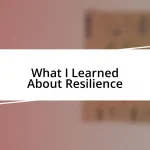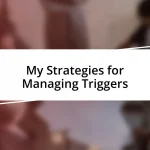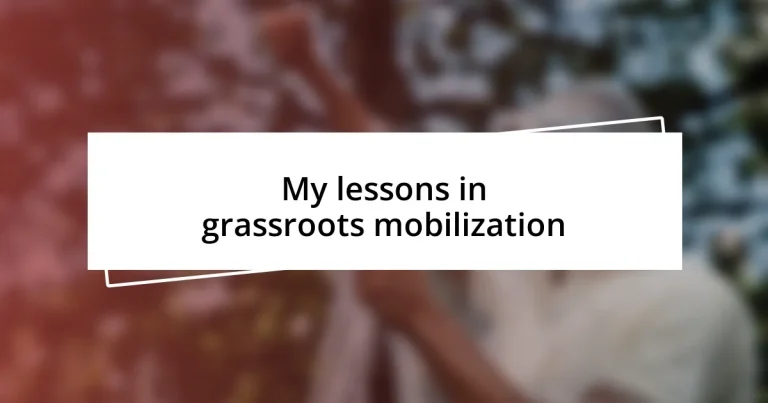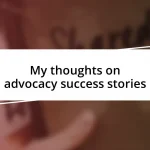Key takeaways:
- Grassroots mobilization thrives on the power of community engagement and personal connections, facilitating meaningful relationships that drive collective action.
- Effective mobilization relies on key principles such as building trust, empowering voices, and celebrating small wins to maintain momentum and involvement.
- Strategies for volunteer engagement include personal outreach, leveraging individual skills, and storytelling to foster a deeper sense of purpose and connection.
- Measuring impact through surveys, engagement metrics, and personal stories enhances understanding of a mobilization’s effectiveness and highlights the lives influenced by the efforts.
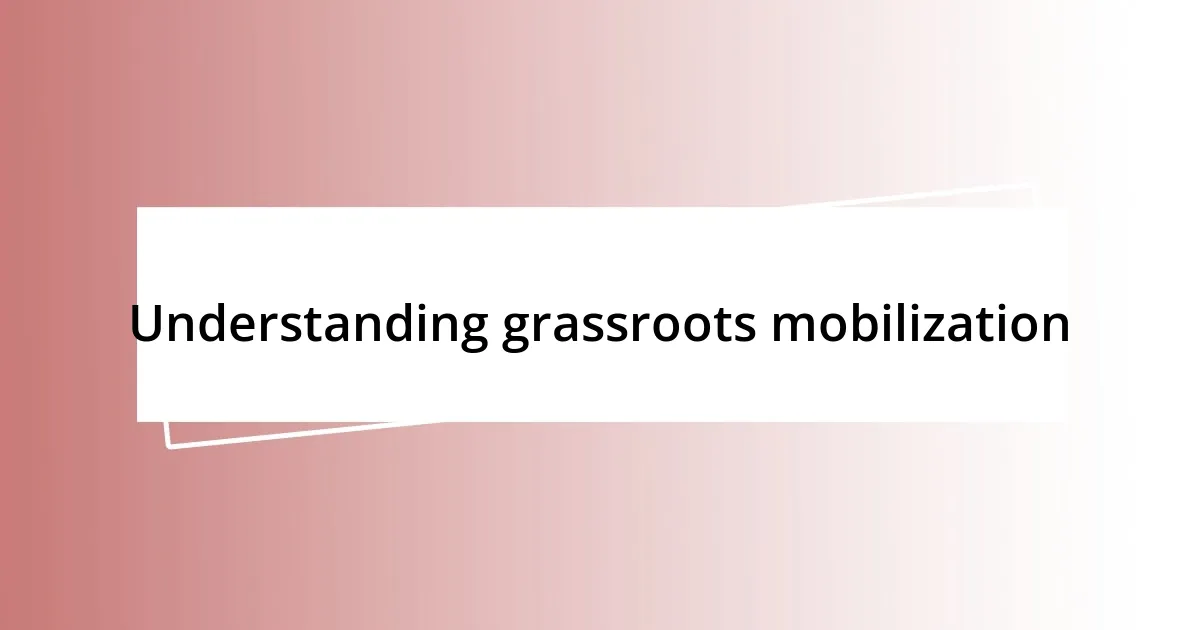
Understanding grassroots mobilization
Grassroots mobilization is fundamentally about people coming together to advocate for change. I remember the first time I participated in a community event; it was invigorating to see so many passionate faces united for a common cause. Have you ever felt that spark of energy in a crowd? It’s electric, and it underscores the power of collective action.
At its core, grassroots mobilization taps into the strengths of local communities. I’ve found that when people feel directly connected to an issue, their commitment grows exponentially. For instance, my neighborhood organized a clean-up event that not only beautified our parks but also fostered new friendships and a sense of belonging. Isn’t it amazing how a simple initiative can create lasting bonds among participants?
Understanding the dynamics of grassroots mobilization involves recognizing that it’s not just about the big movements – it’s often the small, local actions that lead to significant change. Reflecting on my experiences, I often wonder, how many meaningful conversations and relationships are built within these grassroots efforts? Each story, each interaction, adds another layer to the movement, highlighting the impact we can achieve when we lift each other up.
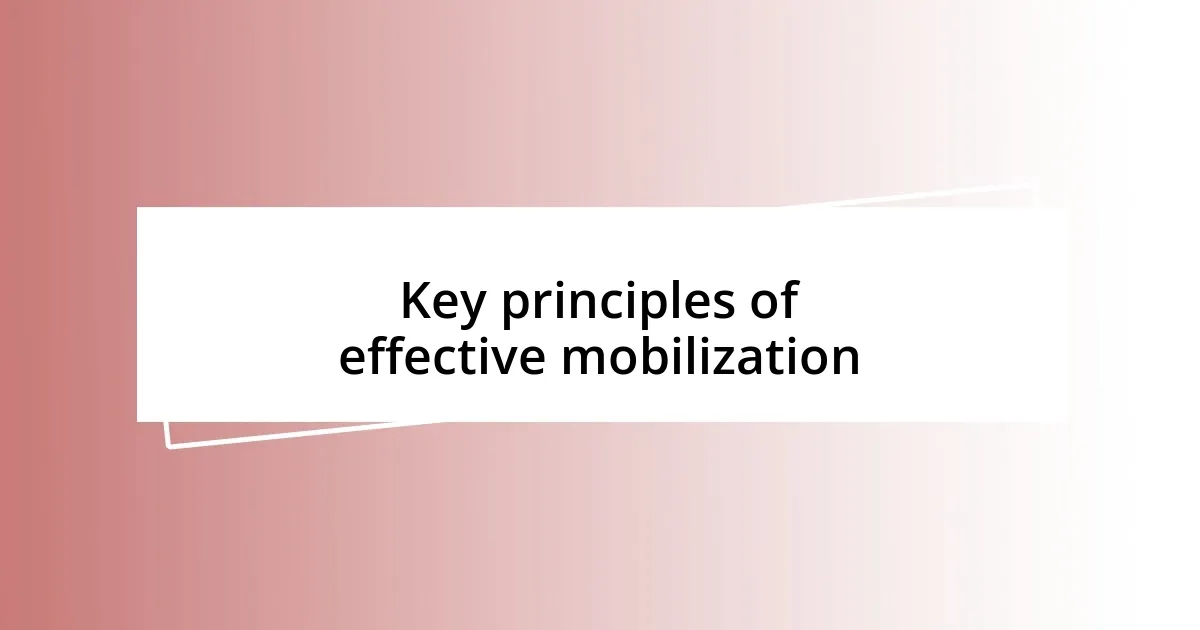
Key principles of effective mobilization
Effective mobilization hinges on a few key principles that can amplify impact and ensure a cohesive movement. Drawing from my own experiences, I’ve seen firsthand how genuine relationships lay the groundwork for sustained engagement. For example, during a food drive I helped organize, the connections formed among volunteers forged a network of support that extended beyond just that one event. It was illuminating to witness how those relationships sparked new initiatives, showing me the importance of nurturing community ties.
Here are some essential principles for effective mobilization:
- Build Trust: Authentic relationships create a foundation that encourages people to support your cause actively.
- Empower Voices: Ensuring that everyone, especially those directly affected, can share their stories fosters deeper connections and understanding.
- Stay Consistent: Regular communication and follow-up keep the momentum alive and reinforce commitment.
- Celebrate Small Wins: Acknowledging progress, no matter how small, keeps spirits high and encourages further participation.
- Adapt and Learn: Being flexible to change based on feedback allows a movement to evolve and respond to community needs.
In my journey, I’ve learned that mobilization isn’t just about the end goal; it’s about the bonds we create along the way. Each step taken together fuels a sense of belonging and purpose, which is truly the heart of grassroots movements.
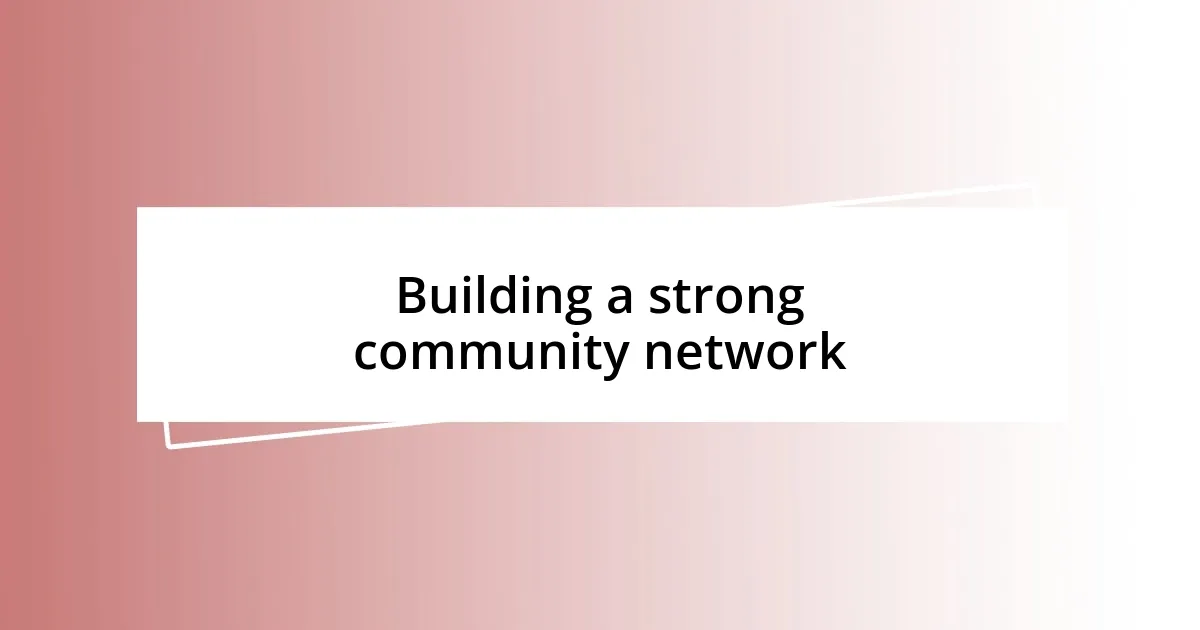
Building a strong community network
Building a strong community network is essential for grassroots mobilization. From my experiences, the magic often lies in small gatherings where shared interests and passions emerge. I remember attending a neighborhood potluck where residents connected over home-cooked dishes, ultimately sparking discussions about local concerns. Such informal settings create a sense of belonging, establishing a foundation that invites collaboration and dialogue.
Forming a robust network also requires persistent effort. I found that regularly organizing workshops around community interests helps strengthen relationships. For instance, after hosting a series of discussions on environmental sustainability, participants not only shared ideas but later teamed up for various initiatives. Those bonds transformed casual acquaintances into dedicated allies, illuminating the power of sustained engagement.
Moreover, it’s crucial to celebrate milestones, no matter how small. I recall the thrill of our community’s first successful tree-planting event. The excitement was palpable, and we took a moment to recognize everyone’s efforts. Celebrations like these not only reinforce the importance of shared accomplishments but also motivate continued efforts, solidifying the network further.
| Key Elements | Description |
|---|---|
| Informal Gatherings | Creating spaces for casual interaction fosters trust and connection. |
| Workshops and Discussions | Regular events focused on community interests deepen relationships and encourage collaboration. |
| Celebrating Milestones | Acknowledging achievements, big or small, boosts morale and strengthens community ties. |
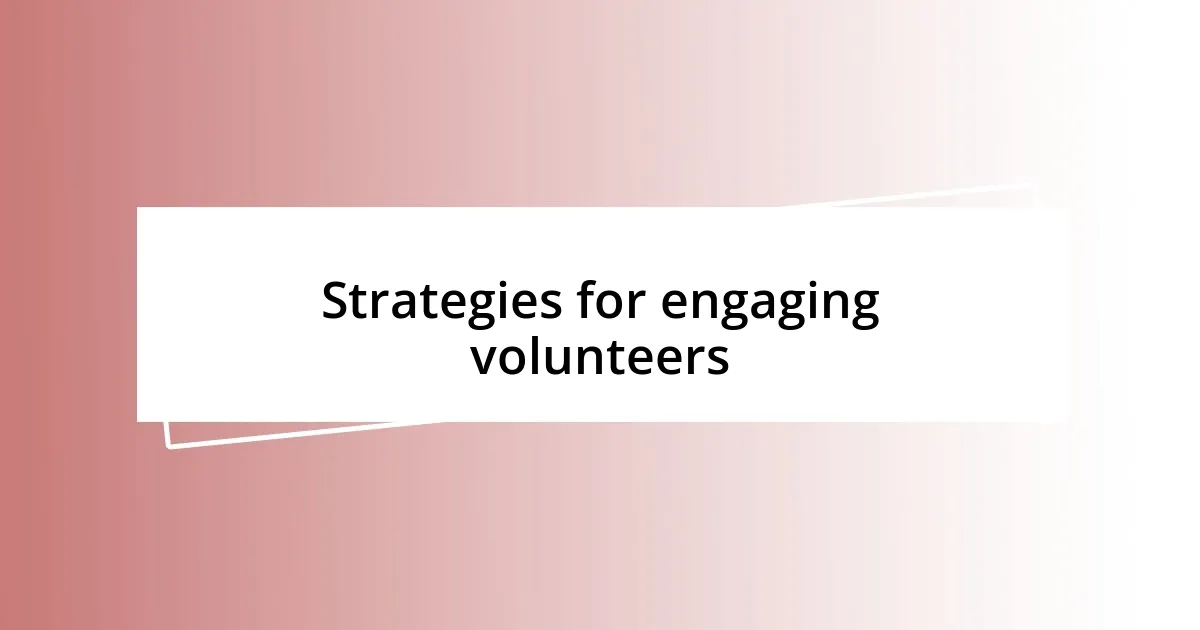
Strategies for engaging volunteers
To effectively engage volunteers, one strategy I’ve found particularly impactful is personal outreach. There’s something powerful about a one-on-one conversation that makes volunteers feel valued and important. I remember reaching out to a friend to join a fundraising event. What started as a casual invitation turned into a deep discussion about our shared commitment to the cause, ultimately leading to her becoming one of our most enthusiastic advocates. Have you ever noticed how a personal touch can transform someone’s perspective?
Another vital approach is to tap into volunteers’ passions and skills. When I was organizing a community clean-up, I discovered that a few of our volunteers were graphic designers. By allowing them to create promotional materials, we not only utilized their talents but also made them feel invested in the project’s success. It’s rewarding to see people light up when they can contribute in a way that resonates with their personal strengths. Isn’t it amazing how empowering volunteers can enhance their motivation?
Lastly, I believe that storytelling plays a crucial role in keeping volunteers engaged. Sharing stories of those impacted by our efforts creates a powerful connection that motivates individuals to keep coming back. During one project, I shared a heartfelt email from a family that benefited from our work, and the response was incredible. It seemed like a wave of renewed energy swept through our team. Have you felt that sense of purpose when you witness the real difference your work makes? Engaging volunteers isn’t just about tasks; it’s about making them feel part of a larger narrative.
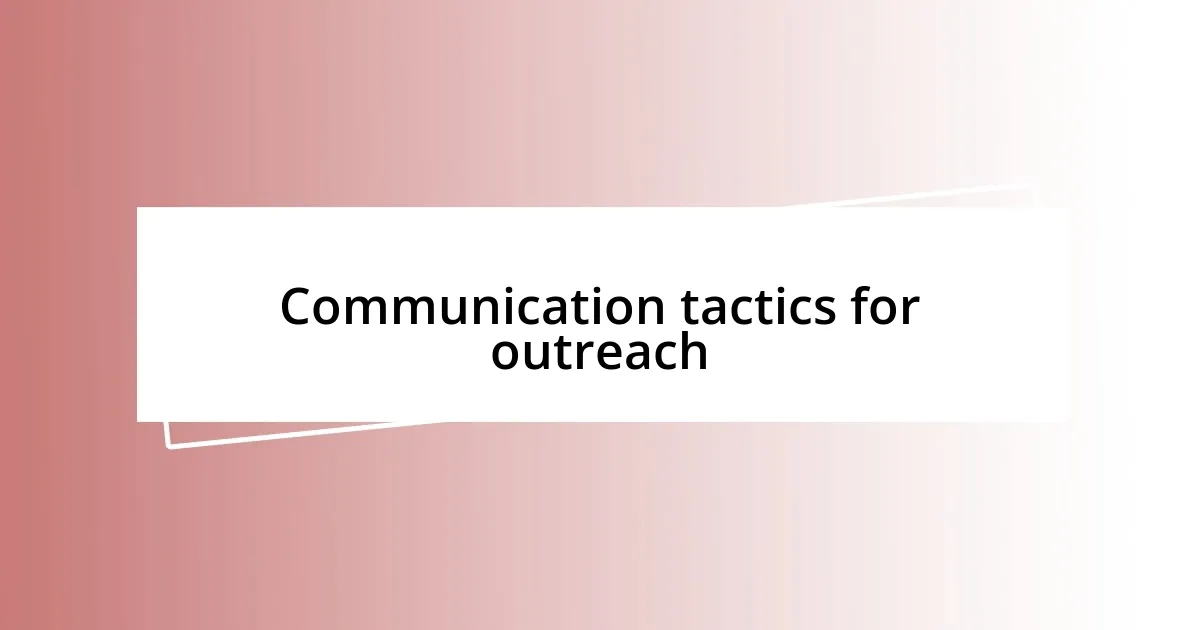
Communication tactics for outreach
Effective communication tactics can significantly enhance outreach efforts in grassroots mobilization. I recall one summer when I decided to use social media to share our upcoming events. I crafted relatable posts featuring quotes from community members, all with vibrant images showcasing our initiatives. It was enlightening to see how engagement skyrocketed just from sharing personal stories and visuals. Have you ever considered how a simple post can create waves of interaction?
Additionally, face-to-face interactions remain an incredibly powerful tool. During a local farmers’ market, I set up a booth to engage directly with people. I found that having genuine conversations about our cause allowed me to listen to community concerns and inspire them to get involved. It’s remarkable how much impact a smile and a few minutes of dialogue can have—people walked away feeling not just informed but genuinely connected. Isn’t it amazing how personal touch can elevate community engagement?
Lastly, I’ve learned the importance of follow-ups in maintaining momentum. After hosting an event, I made it a point to send personalized thank-you messages to participants, sharing how their contributions made a difference. Reflecting on this, I realized that these little notes not only strengthened our relationship but also kept them in the loop for future initiatives. Have you noticed how a simple gesture can foster loyalty and enthusiasm? It seems that following up isn’t just a courtesy; it’s an essential part of building lasting community bonds.
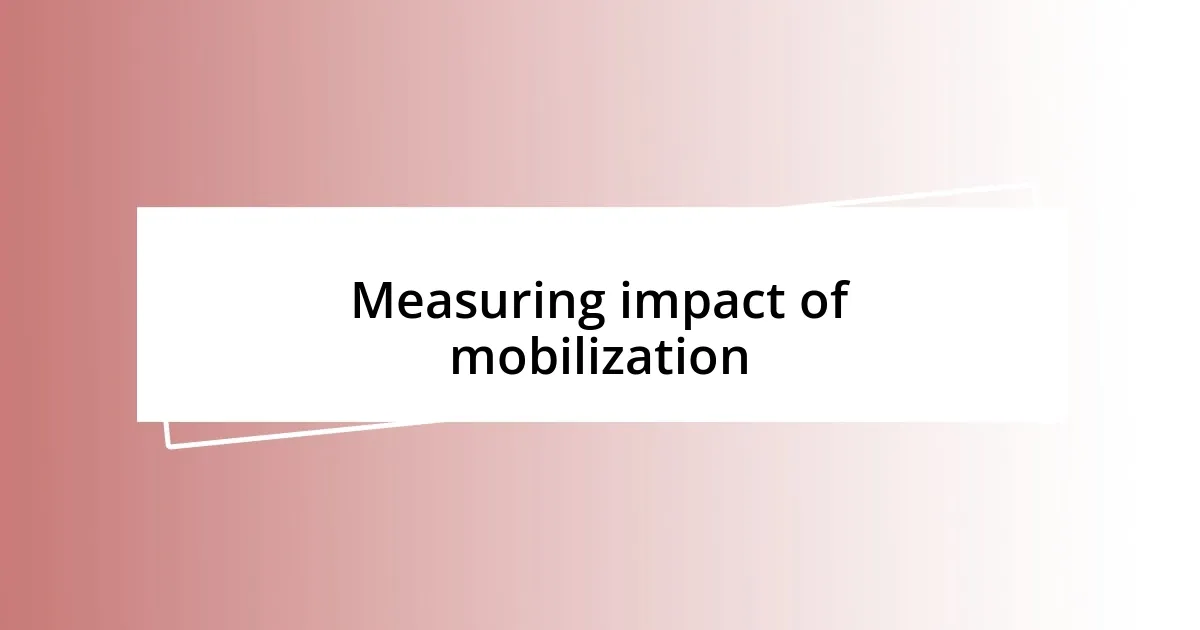
Measuring impact of mobilization
Measuring the impact of mobilization can sometimes feel daunting, but I’ve learned that tracking specific outcomes makes the process manageable. For instance, after a recent awareness campaign, I conducted a survey to gauge community sentiment. It was heartening to discover that 80% of respondents felt more informed about our cause. Have you ever considered how feedback can clarify the impact of your efforts?
I also find that analyzing engagement metrics is invaluable. After launching a petition drive, I darе to compare the number of signatories against previous campaigns. To my surprise, we saw a 50% increase in participation! This kind of analysis not only validates our strategies but also helps refine future tactics. Doesn’t it feel rewarding to have concrete data reflecting your dedication?
Finally, storytelling remains a powerful method for measuring impact. In one project, I interviewed volunteers about their experiences and was deeply moved by their reflections. One volunteer spoke about how their involvement not only fostered personal growth but also created a ripple effect in their neighborhood. This demonstrated that mobilization isn’t just about numbers; it’s about the lives we touch and inspire. Have you reflected on how personal stories of change can provide a deeper understanding of your impact?

Lessons learned from successful campaigns
One key lesson I’ve learned from successful campaigns is the transformative power of local storytelling. During a neighborhood clean-up initiative, I remember chatting with an elderly resident who shared her memories of how the park used to look decades ago. Her vivid recollections created a strong emotional connection among participants, inspiring them to rejuvenate the space together. Doesn’t it amaze you how a single story can ignite a shared sense of purpose?
Another vital insight relates to the impact of diverse involvement. I witnessed the effectiveness of having a broad coalition of voices at one rally where individuals from various backgrounds came together to advocate for environmental policies. Each participant brought unique perspectives and experiences, which not only enriched the discussion but also highlighted our shared goals. Have you ever thought about how diversity in a movement can enhance creativity and drive?
Lastly, I believe persistence is crucial for success. In one campaign to improve local public transport, we faced numerous setbacks, including unfavorable city council meetings. Yet, we decided to continue engaging with community members through regular updates and open forums. Over time, our sustained efforts not only kept the conversation alive but also attracted more supporters. Reflecting on this, do you feel that resilience in grassroots work is just as essential as the initial spark that ignites the movement?
